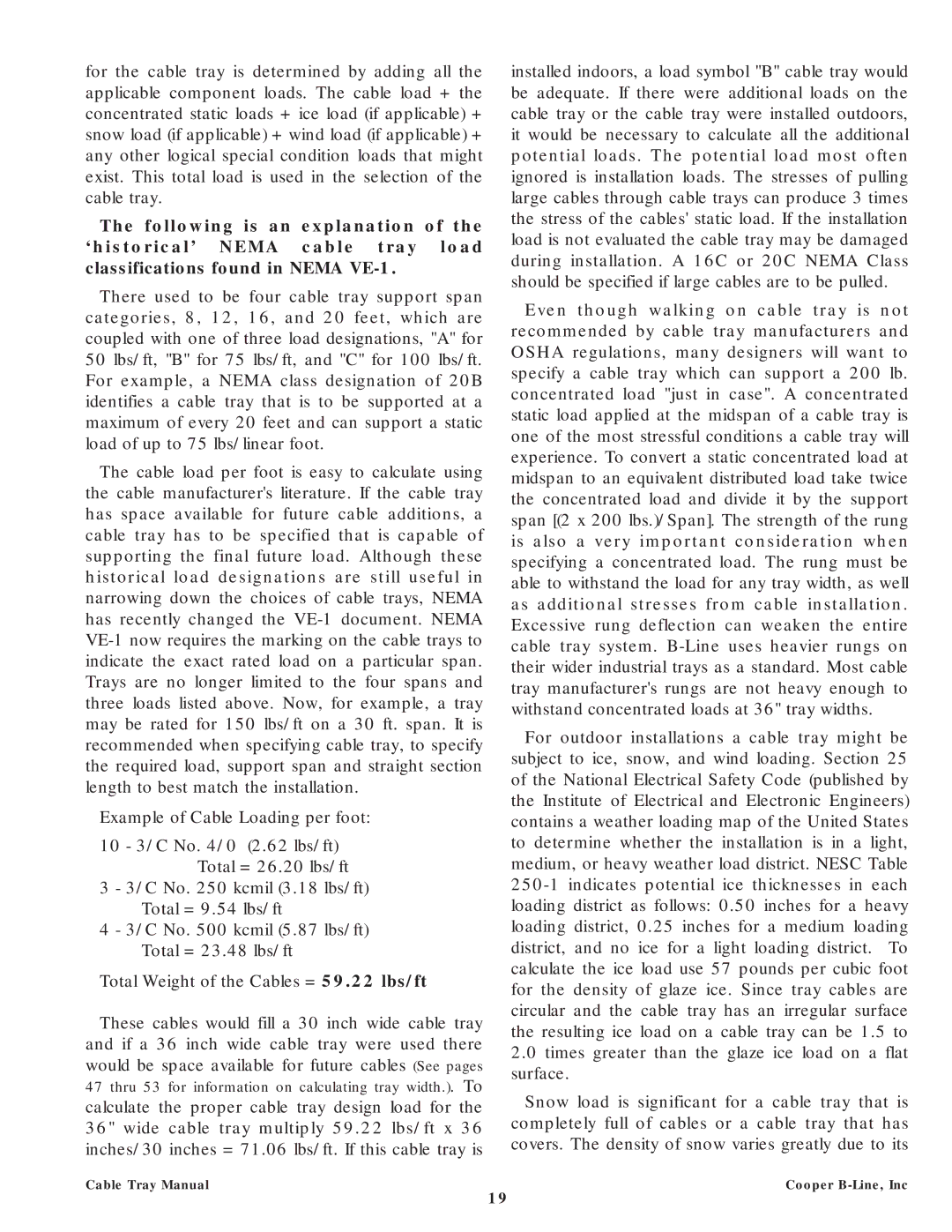for the cable tray is determined by adding all the applicable component loads. The cable load + the concentrated static loads + ice load (if applicable) + snow load (if applicable) + wind load (if applicable) + any other logical special condition loads that might exist. This total load is used in the selection of the cable tray.
The following is an explanation of the ‘historical’ NEMA cable tray load classifications found in NEMA
There used to be four cable tray support span categories, 8, 12, 16, and 20 feet, which are coupled with one of three load designations, "A" for 50 lbs/ft, "B" for 75 lbs/ft, and "C" for 100 lbs/ft. For example, a NEMA class designation of 20B identifies a cable tray that is to be supported at a maximum of every 20 feet and can support a static load of up to 75 lbs/linear foot.
The cable load per foot is easy to calculate using the cable manufacturer's literature. If the cable tray has space available for future cable additions, a cable tray has to be specified that is capable of supporting the final future load. Although these historical load designations are still useful in narrowing down the choices of cable trays, NEMA has recently changed the
Example of Cable Loading per foot:
10 - 3/C No. 4/0 (2.62 lbs/ft) Total = 26.20 lbs/ft
3 - 3/C No. 250 kcmil (3.18 lbs/ft) Total = 9.54 lbs/ft
4 - 3/C No. 500 kcmil (5.87 lbs/ft) Total = 23.48 lbs/ft
Total Weight of the Cables = 59.22 lbs/ft
These cables would fill a 30 inch wide cable tray and if a 36 inch wide cable tray were used there would be space available for future cables
47 thru 53 for information on calculating tray width.). To calculate the proper cable tray design load for the 36" wide cable tray multiply 59.22 lbs/ft x 36 inches/30 inches = 71.06 lbs/ft. If this cable tray is
Cable Tray Manual
installed indoors, a load symbol "B" cable tray would be adequate. If there were additional loads on the cable tray or the cable tray were installed outdoors, it would be necessary to calculate all the additional potential loads. The potential load most often ignored is installation loads. The stresses of pulling large cables through cable trays can produce 3 times the stress of the cables' static load. If the installation load is not evaluated the cable tray may be damaged during installation. A 16C or 20C NEMA Class should be specified if large cables are to be pulled.
Even though walking on cable tray is not recommended by cable tray manufacturers and OSHA regulations, many designers will want to specify a cable tray which can support a 200 lb. concentrated load "just in case". A concentrated static load applied at the midspan of a cable tray is one of the most stressful conditions a cable tray will experience. To convert a static concentrated load at midspan to an equivalent distributed load take twice the concentrated load and divide it by the support span [(2 x 200 lbs.)/Span]. The strength of the rung is also a very important consideration when specifying a concentrated load. The rung must be able to withstand the load for any tray width, as well as additional stresses from cable installation. Excessive rung deflection can weaken the entire cable tray system.
For outdoor installations a cable tray might be subject to ice, snow, and wind loading. Section 25 of the National Electrical Safety Code (published by the Institute of Electrical and Electronic Engineers) contains a weather loading map of the United States to determine whether the installation is in a light, medium, or heavy weather load district. NESC Table
2.0times greater than the glaze ice load on a flat surface.
Snow load is significant for a cable tray that is completely full of cables or a cable tray that has covers. The density of snow varies greatly due to its
Cooper B-Line, Inc
19
